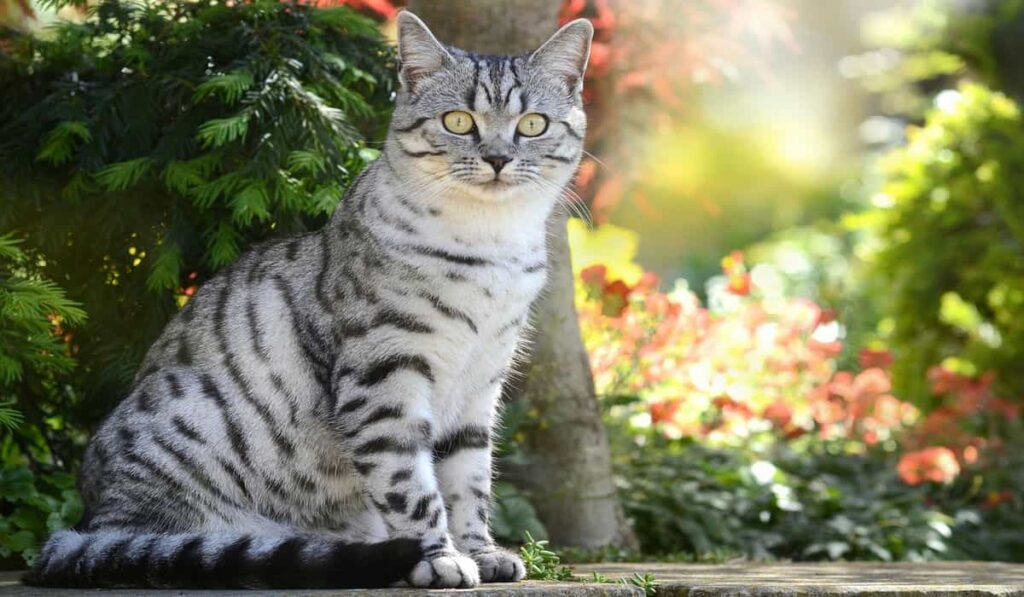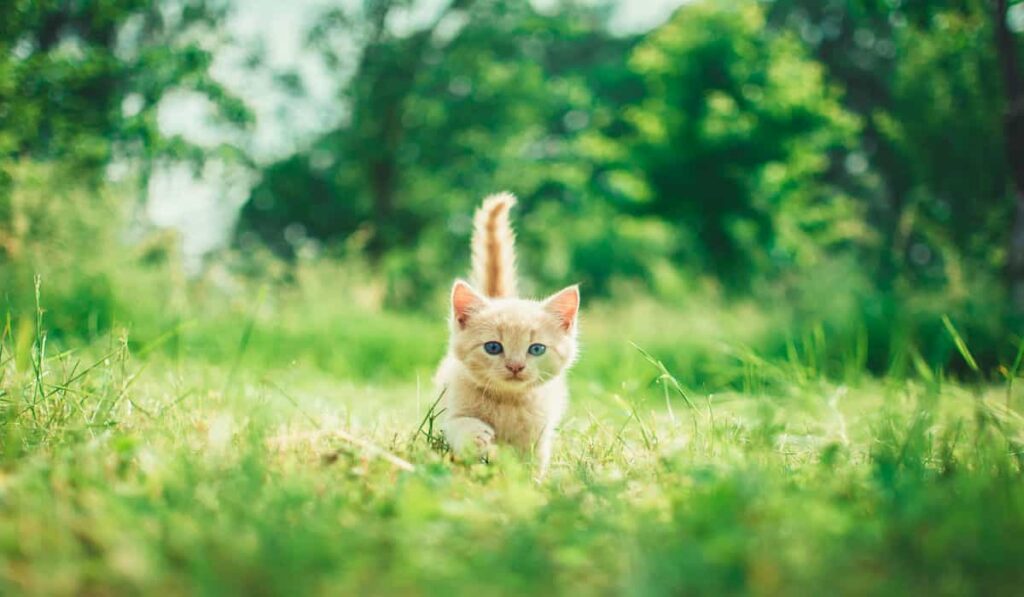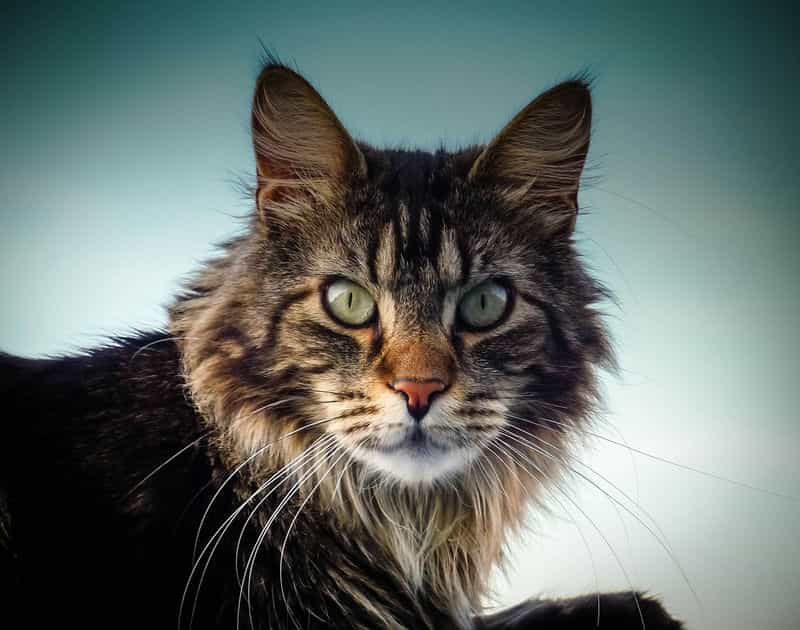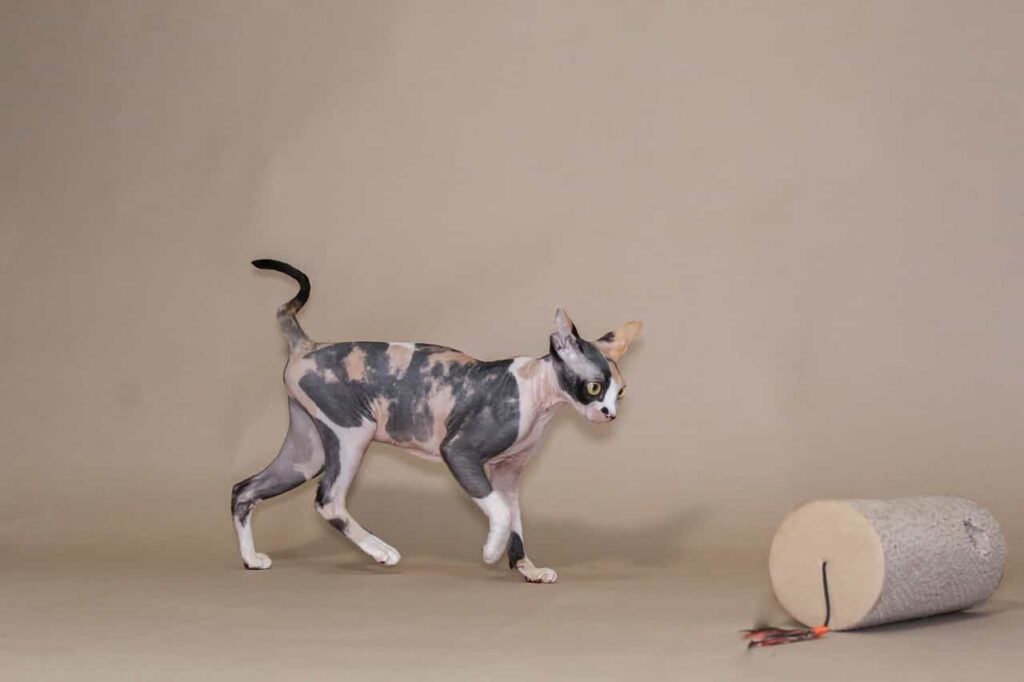Welcome to the enchanting world of the Japanese Bobtail cat, a breed that effortlessly captures hearts with its unique features and charming personality. This introduction invites you into the realm of these fascinating felines, renowned not just for their distinctive bobtail but also for their playful and affectionate nature. Japanese Bobtail Cat care tips are crucial for prospective and current owners, as this breed’s unique characteristics, including its behavior and personality, require specific attention.
Dive into the captivating history of the Japanese Bobtail Cat breed, from ancient folklore to modern-day homes, and discover why these cats are not just pets but symbols of luck and prosperity in Japanese culture. Embrace the journey of understanding these adorable creatures, where every fact about their care, from grooming needs to diet, unfolds like a well-crafted tale, drawing you closer to the essence of the Japanese Bobtail Cat.
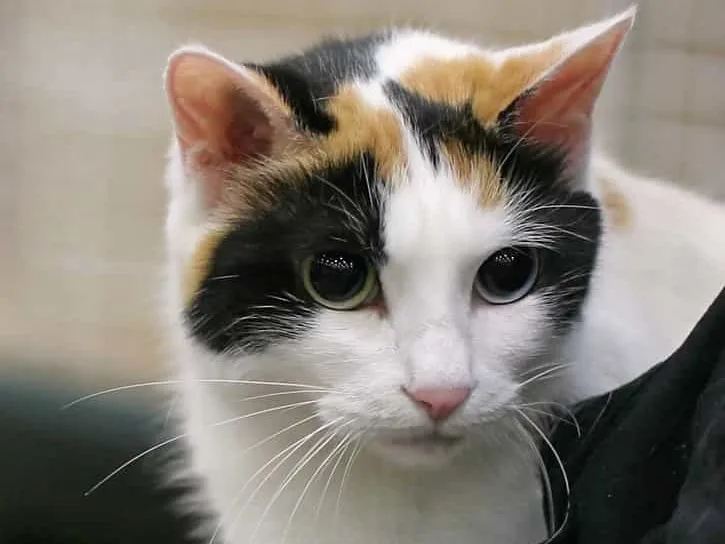
Table of contents
Japanese Bobtail Cat
The Japanese Bobtail cat is a breed of domestic cat. It is a natural breed with unusual Bobtails. The Bobtails resemble busy bunny tails, not any other cats. Many people have a confusion between the JBT, ABT (American), and Manx cat breeds but I assure you that the 3 breeds are totally different cat breeds.
However, though the breed originated in Japan and became a part of their culture, art, and folks for centuries, this cat breed is found all over the world now. The most significant trait of the breed is their bobtails which are called ‘Pom’ by cat enthusiasts. Though the tails are bushy like the Bunnys they can be straight, kinked, or bent.
Breed specialty of the Japanese Bobtail cat
Other names:
Maneki Neko cat, Pom, Japanese Truncated Cat, Beckoning cats.
Personality and nature:
Affectionate, friendly, playful, sociable, active, agile, clever, intelligent, energetic, adaptable, and loyal.
Body length:
Up to 14 inches.
Body weight:
Males are up to 10 Pounds and females are up to 8 Pounds.
Coat length:
Both Long and short lengths.
Coat colors:
White, Black, Red, Brown, Blue, Cream, Chocolate, Lilac, Mi-ke, Orange, Ruddy, Tan, and so on.
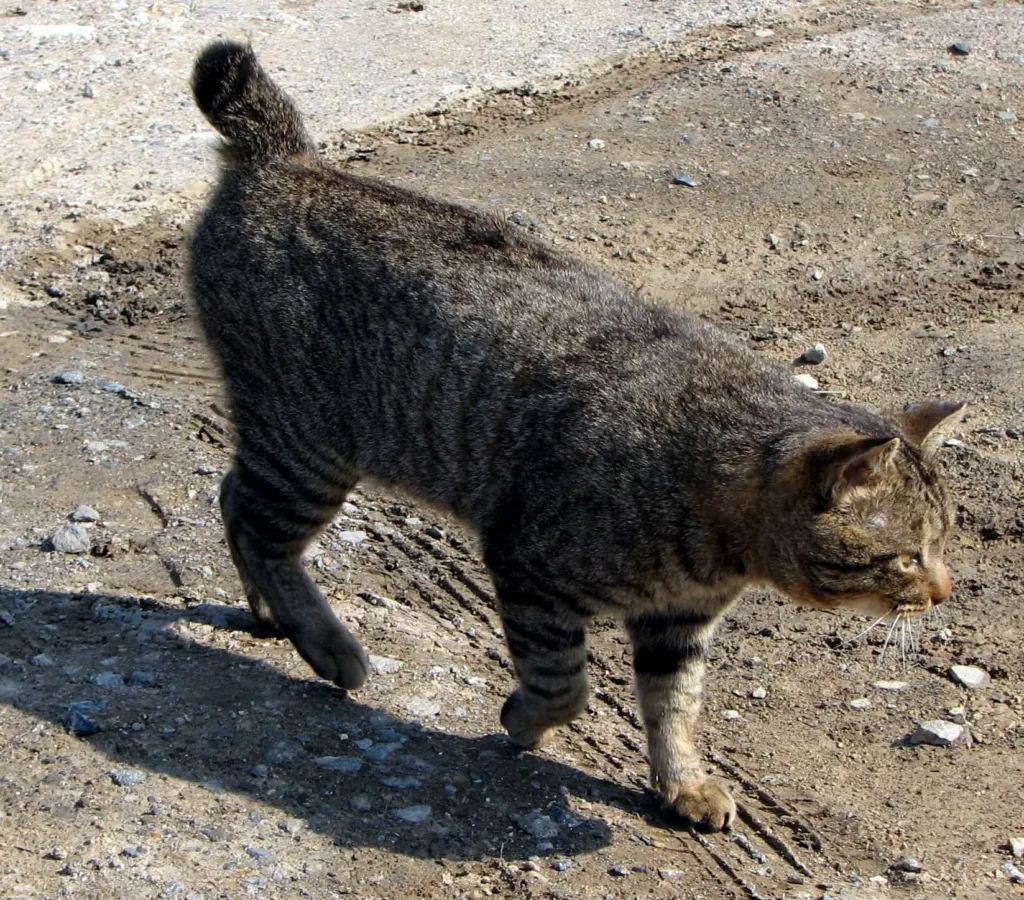

Coat patterns:
Solid, Tortoiseshell, Bi-color, Tri-color/ Calico, Tabby, Harlequin, Van, Smoked, and Shaded.
Eye colors:
Blue and Gold are the most common eye colors but Copper, Amber, Aqua, Green, Hazzle, Orange, yellow, etc.
Friendliness to other children and pets:
High
Maintenance:
Moderated
Shedding amount:
Moderated
Life cycle:
Up to 18 years
Allergenic tendency:
Low
Origin:
China, Korea, and Japan.
Origin of the Japanese Bobtail Cat breed
The Japanese Bobs have more than a thousand years long history. Three are several interesting histories related to the JBT breed.
One of them is the short-tailed cats that arrived in Japan around 1500 years ago with the monks who came from China and Korea to mission Buddhism in Japan. They have short-tailed pet cats and they used those cats to fight against rodents to save the rice stored inside the Pagodas.
Another history is, the Bobtails are originally from China and Korea. The Emperor of China gifted the Bobcats to the Emperor of Japan in the 7th century. From them, the Bobtail cats are known as Japanese Bobtail cats.
In 1602, the Japanese Emperor decreed that the selling and buying of Japanese Bobtails are totally banned and only the royal people and the elite class can pet the Bobs. the rest of the people can’t do this and for this reason, the JBTs became the farm and warehouse cats to prevent the rodents, mice, and other animals because they became as a threat to Japan’s silk trade.
At that time, Bobtails are seen only on the streets and in market areas. The JBTs became a part of Japan’s paintings, arts, and culture. There is a happily raised paw in the curio shops and restaurants of Japan named The Beckoning Cat. it Japanese language, it is called Maneki Neko.
Even the famous cartoon character ‘Hello Kitty’ is also a JBT. Here, I would like to mention that the creator of Hello Kitty didn’t declare that Hello Kitty is a JBT but both cats resemble each other.
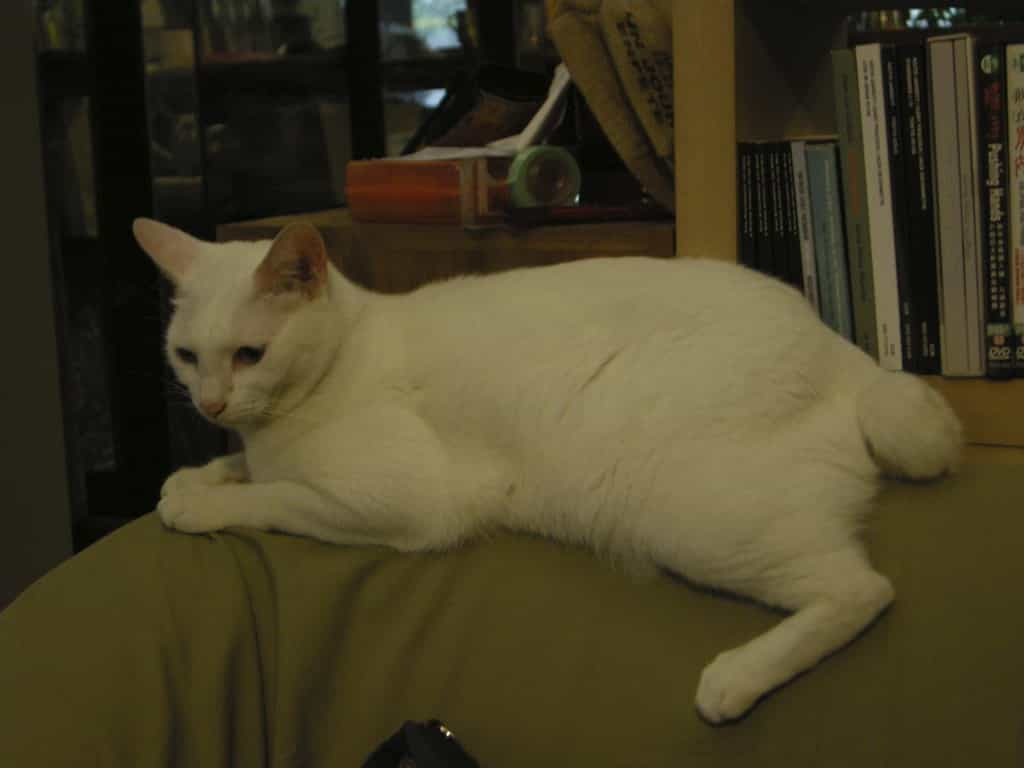

More about Japanese Bobtail cat Origin
A book was written by a foreign writer on the Flora, Fauna, and landscapes of Japan, named ‘Kaempfer’s Japan’, in 1701. It was the first book written on Japan’s nature. Englebart Kaempfer was a German Nature sciectist. He mentioned a cat in his book that the cat has large patches of yellow, Black, and White fur, and its short tails look like bent or broken.
The Japanese Bobs made their way to the USA in the 1960s first. The credit goes to a woman, named Elizabeth Freret. She imported the breed to the USA in 1968. Soon the people of the USA fell in love with Bob’s personality and unique appearance.
The shorthaired version of the Japanese breed got recognized and championship status by the Cat Fancier’s Association in 1976. Following that the longhaired version got recognized in 1993. Only the Governing Council of the Cat Fancy- GCCF-the domestic cat association of the UK didn’t give recognition to the breed.
By 2013, there are a few numbers of JBT breeders who are mostly from North America, and a few from Japan and Europe. The breed is still in rarity.Till the high-tech age, Japanese Bobtails are a sign of Happiness, and prosperity, and attracts good people.
The appearance of the Japanese Bobtail Cat breed
There is a funny thing about the JBT sometimes people get confused between JBT and Manx cat breed. But the 2 breeds are totally different from each other.
Body:
Bob’s bodies are medium-sized with a body length of up to 14 inches and body weight Males are up to 10 Pounds and females are up to 8 Pounds. The bodies are not tubular and stockier. It is long, torso, and lean.
Head:
The heads are equally tri-angled and the ears and not included.
Ears:
The ears are alert, wide-based, and situated on the top of the head’s corner.
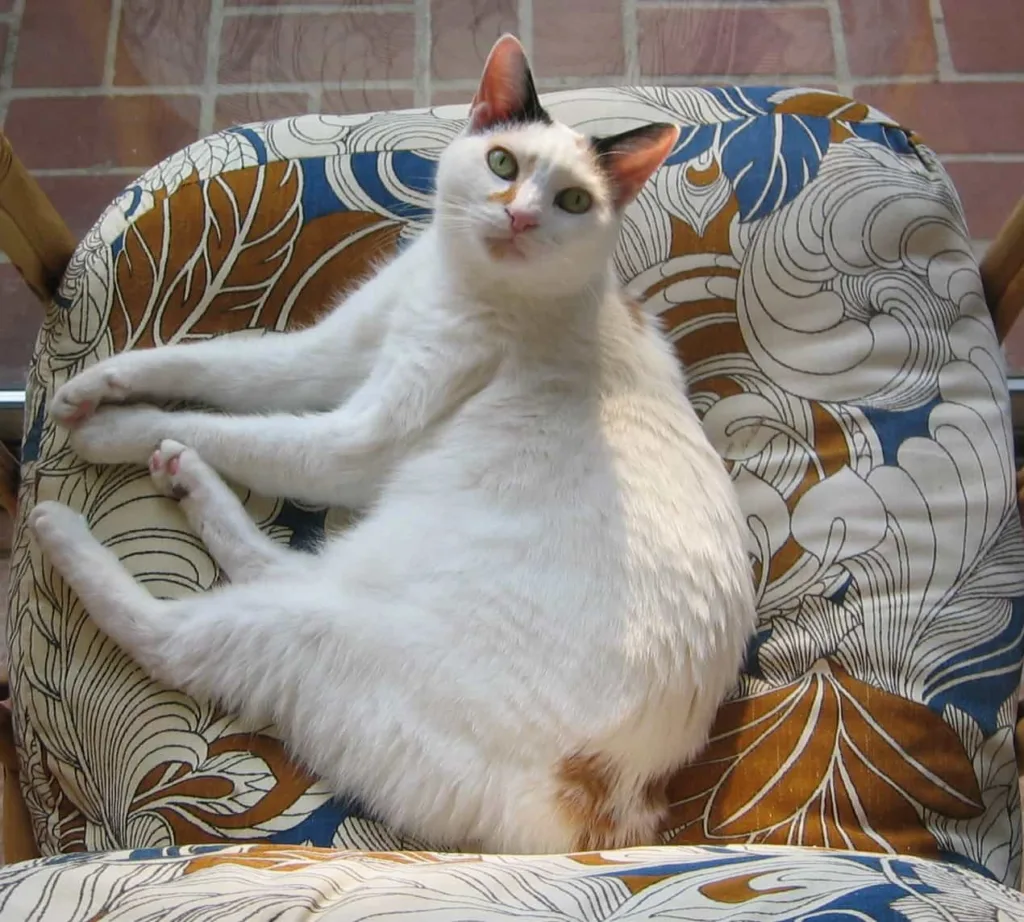

Muzzles:
Fairly broad and round, neither pointed nor Blunt.
Eyes:
The eyes are oval-shaped, large, floating, and also alert all the time. Blue and Gold are the most common eye colors but Copper, Amber, Aqua, Green, Hazzle, Orange, yellow, etc.
Neck:
The necks are fairly proportioned to the body that holds the head.
Legs, paws, and toes:
The animal’s legs are usually long and JBTs are not the different creatures at all. Their legs are proportionate to the body and hindlegs are as usual longer and curvy than the back legs. Paws are oval and broad, and toes are five in front and 4 in back.
Tails:
Japanese Bobtails are never tailless. Their tails are clearly visible. The tails are curved as if bent or broken.
Coats (Short):
Soft and silky
Coats (Long):
Medium to long, soft-textured and silky, gradually lengthening towards the rump.
Coat colors:
White, Black, Red, Brown, Blue, Cream, Chocolate, Lilac, Mi-ke, Orange, Ruddy, Tan, and so on.
Coat patterns:
Solid, Tortoiseshell, Bi-color, Tri-color/ Calico, Tabby, Smoked, and Shaded. The Harquelin and Van pattern that means their full body is solid White except for the crown of the head and tail. Other patterns have so many colors.
Temperament and nature of the Japanese Bobtail cat breed
One of the most ancient, adaptable, friendly, curious, intelligent, active, playful, agile, clever, and quick learner breeds is the Japanese Bob. they are also very vocal, and most of the time they chirp to interact with humans. Animals vocalize to contact humans, not contact other animals.
A very good pet for families and all kinds of people like children and even other pets. The most significant trait of the JBT is their highly adaptable nature. Though they can adapt even to unusual situations, they should be kept indoors. They are even traveler kitties. You can take them on your foreign trip.
They’re the singing cats. They’ll entertain you with theri sweet chirping. They’re also always up for anything and are keen to learn new tricks. You have to find stronger excuses to avoid this lovely kitty.
Japanese Bobtail Cat relationships with their families
A very good and wise choice for the family lives. They can adjust to both small and big families and both big and small houses. They’re also with childrens but remember that when your children are small like toddlers, you must supervise them while interacting with them. The intelligent Bobs are very much attached to human nature. They can understand when their owners are sad and upset and at that time they don’t disturb them.
The relationship between Japanese Bobtails and other pets:
Well, the JBTs are bossy and territorial. It doesn’t matter how many other pets are in your house the Bobs will take them under their charge. If other pets don’t tolerate this then there will be an unhappy situation created in your house.
The JBTs can do well more with dogs because both the animals have the same characteristics. The Bobs usually don’t do well with the nin-related cats. They’re very fond of their littermates and keep a lifetime relationship with them and not very much friendly with small animals. So, you should keep small animals like birds, Guinea pigs, and other animals safe from the Bobs.
Male VS female Japanese Bobtails
Males are as usually larger than females. Males are up to 14 inches in length and 10 pounds in weight and females are up to 12 inches in length and 8 pounds in weight.
Both genders get heated twice a year if they aren’t spayed and neutered. At that time they get more vocal and short-tempered. The males spray urine to make their territory if they aren’t neutered. So, if you aren’t planning to breed your kitty then neuter or spay them.
Caring, grooming, exercise, and training for the Japanese Bobtail cat
Grooming:
Both the longhaired and shorthaired versions of JBT have no undercoats. So, they don’t shed a lot. Only one-time weekly brushing is fine enough in all seasons. They are very fond of water so you can bathe them monthly once.
Regular toothbrushing is very important for all cats. Brush their teeth daily with cat toothpaste and brushes. Check their nails and ears weekly and trim the nails and clean their ears to avoid mites and infections and also getting injured by their nails.
Japanese Bobtail cat Caring
The caring of the JBTs is normal. Just provide with them interactive and fav toys. They are very fond of water. They can swim and even give you company in the bathtub. So, you better have a swimming pool inside your house.
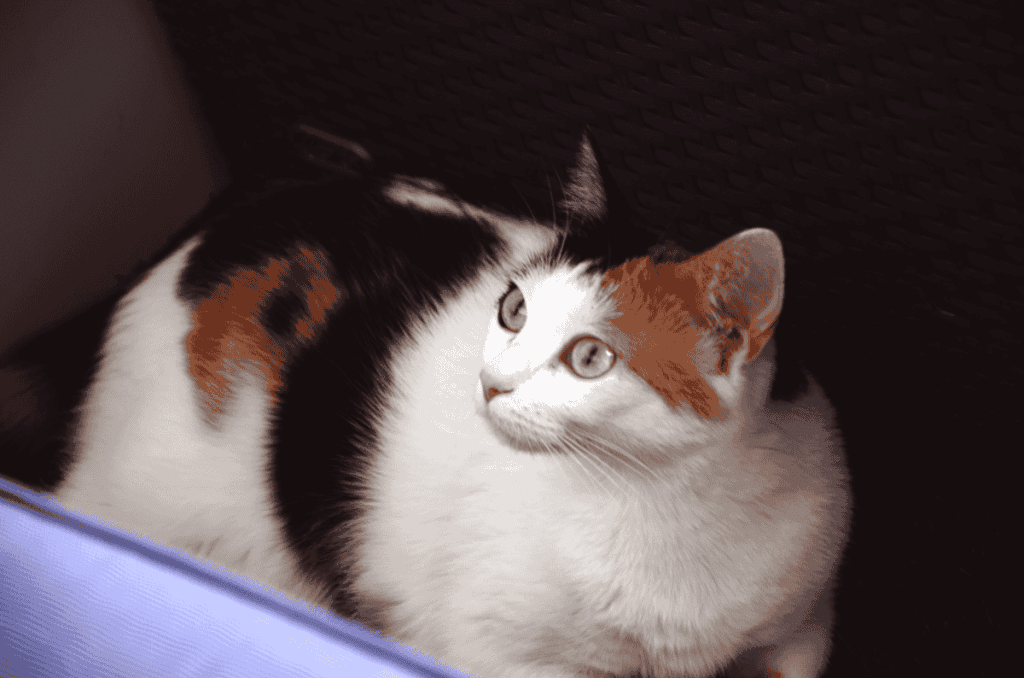

Provide them with a tall cat tree and a high and sunny window so that they can watch the outside view and take a cat nap. They need a lot of mental stimulation and can’t stay alone. So, fix a schedule to accompany your Bob and listen to it while it’s trying to get your attention. You also may have an open playground in your house so they can run and play. Don’t leave them outside without any supervision.
Exercise:
One thing is to be remembered that the animals don’t need any gym or equipment for exercising. Their playing is their exercise. So, just provide them the opportunity to play. This will be the best exercise for them and obviously. If you spend some time with them daily they will be happier playing and exercising.
Training:
The Japanese Bobs are very intelligent, clever, smart, and intelligent, and also quick learners. They can pick any training very quickly. Positive Reinforcement Training is the best training for Japanese Bobtails. You can reward them with food for doing anything good. Clicker training, leash training, and potty training are essential for the breed.
Health and problems of the Japanese Bobtail cat
Generally, the JBT is a healthy breed. They don’t have any serious breed-related issues. A regular vet check-up is enough to keep your kitty healthy and happy.
Like other cats they are prone to:
Infections and viruses:
If your kitty fights with other animals so they may get infected by viruses. so, keep them indoors so that they can’t fight and also make sure that they can’t walk on wet soil. The worm’s mat gets entered by walking on the wet soil.
Hypertrophic Cardio Myopathy (HCM):
One kind of heart disease. When the heart walls are thickened and make obstacles to producing and generating blood- this is called HCM.
Kidny diseases:
Another very common disease among felines. Just provide plenty of fresh and clean water daily to your kitty.
Obesity:
All cats are prone to get obsessed. So, you have to be very careful so they can’t be obese.
Feline Lower Urinary Tract Diseases (FLUTD):
All young male cats including JBTs are prone to FLUTD. So, take good care of your male JBT.
Dental issues:
A very common problem in all cats. So, take good care of your pet’s dental health.
Food and nutrition tips for the Japanese Bobtail Cat breed
The Japanese Bobtails like to eat. So, there is a high risk of getting obsessed. So, maintain a schedule and a measurement cup to feed your kitty. Both the commercial and homemade food are very good for your Bob but if you’re feeding homemade food then you must take the instructions from the veterinarian or the breeders from whom you have purchased your kitty.
The commercial feline diet is highly appreciable because there are very important food nutrients are added to the high commercial diet. You also provide with them plenty of fresh and clear water daily. Add a water fountain to the water pot so that your kitty gets more interested to drink water.
The breed standard of Japanese Bobtail cat recognized by the Cat Fancier’s Association (CFA):
You may know that the Cat Fancier’s Association (CFA) is a world-recognized cat association. It was established in 1906. CFA determines a standard for every cat breed that it gives recognition to. So, I am telling you about their coat color, and patterns that are recognized by CFA.
Coat colors:
Solid colors:
White, Black, Red, Chocolate, Blue, Lilac, and Cream.
Bi-colors:
Black and White, Red and White/ Red Tabby and White/ Red Tabby and White.
Other Bi-colors:
Chocolate and White, Blue and White, Lilac, and White, Brown/ Tabby patterned and White, and so on.
Tri-color/ Calico pattern:
Mi-Ke:
Black, Red, and White with any combination. Red areas have Tabby/ Classic/ Mackerel, Spotted, or Ticked.
Parti-colors:
Tortoiseshell, Chocolate Tortoiseshell, Blue-Cream, Lilac-Cream.
Coat patterns:
Tabby, Patched Tabby, Smoked, and Colorpoint coat patterns.
Note: if you want to know more about the breed standard of cats then please visit the website of The Cat Fancier’s Association (CFA).
Some facts about the Japanese Bobtail cat breed
- The Japanese Bobtail is the oldest breed of cat. Legends and history say that the breed was known from the 7th century.
- All JBT have kinked or broken tails but the tails are different from cat to cat. No similarities between them.
- Maneki Neko: in Japan, the JBTs are known also as Maneki Niko or Mi-Ke. That means they are the the Beckoning cats. They are still considered as the lucky champ and also greet you in the restaurants and antic shops to attract the good people.
The cute kitten names of the Japanese Bobtail Cat
Male names:
Simba, Momo, Oliver, Buddy, Mikesch, Coco, Achmed, Gavin, Chunk, Nugget.
Female names:
Daisy, Maya, Sassy, Tippy, Emma, Sophie, Pepsi, Ayla, Molly, and Maisy.
The overview of the Japanese Bobtail breed
A very ancient and natural cat breed is the Japanese Bobtails. It has a history of centuries in Japan, China, and Korea. Whatever its origin was, the truth is that this is a very honored, and considered a lucky champ in Japan.
The most significant body trait of this breed is its erectile tails. You’ll never find a straight-tailed JBT cat. These kitties are also very adaptable, friendly, and intelligent. Their body size is up to 14 inches in length and 10 Pounds in weight. A very rare cat breed.
Getting tips for a Japanese Bobtail cat
As you know that the JBT is a very rare breed so, it is challenging to get them. There are very few breeders of Japanese Bobtails all over the world. So, there is a high chance to get scammed. The cat associations publish the lists of every cat breeder. So, please check the websites so that you can get the original lists of breeders.
Websites: The Cat Fancier’s Assocaition (CFA)
National Breed Council
Tailless Cat Rescue
Talk to the passionate breeders and wait. Don’t make a hurry to get one and be deceived.
Japanese Bobtail vs. Other Breeds
When comparing the Japanese Bobtail to other cat breeds, its unique characteristics stand out distinctly. The Japanese Bobtail, known for its playful and social behavior, differs significantly from other breeds in temperament and physical traits. Its iconic short tail, a result of a natural genetic mutation, sets it apart visually, while the Japanese Bobtail temperament, marked by its sociable and vocal nature, distinguishes it behaviorally from more reserved breeds. In terms of training your Japanese Bobtail, owners will find them more adaptable and intelligent compared to some other breeds, often learning tricks and commands with ease.
This breed’s activity levels are relatively high, encouraging interactive play and engagement, unlike some less active breeds. The social behavior of Japanese Bobtails, especially their tendency to bond strongly with family members, is another point of differentiation. When considering adopting a Japanese Bobtail, potential owners should be aware of these contrasts, as their energetic and affectionate nature might not suit every lifestyle. Understanding these differences is key in ensuring a harmonious match between the breed and its human companions.
Japanese Bobtail Lifespan and Health
The Japanese Bobtail is a breed celebrated not only for its distinctive appearance but also for its robust health and longevity. When considering Japanese Bobtail lifespan and health, it’s heartening to know that with proper care, these cats often enjoy a long and healthy life. They are known for their resilience and lack of breed-specific genetic disorders, a trait that sets them apart from many other breeds. When adhering to Japanese Bobtail Cat care tips, owners can expect their companions to thrive for many years, often reaching into their late teens.
The unique features of the Japanese Bobtail, including their muscular build and agile physique, contribute to their overall health, reducing the risk of common feline ailments. Nonetheless, like all cats, they do require regular veterinary check-ups to monitor for common health issues in Japanese Bobtails and ensure they are in peak condition. A key aspect of their care involves maintaining a healthy diet and exercise routine, which significantly impacts their lifespan. Awareness and proactive management of any potential Japanese Bobtail Cat allergies are also crucial in safeguarding their health. Overall, with the right care and attention, the Japanese Bobtail is a hardy breed, promising years of companionship and joy.
Best Diet for Japanese Bobtail Cats
Determining the best diet for Japanese Bobtail Cats is vital for maintaining their health and vitality. As with all breeds, Japanese Bobtail Cats thrive on a balanced and nutritious diet that caters to their specific needs. The ideal diet for these cats should be rich in high-quality proteins to support their active lifestyle, aligning with feeding guidelines for Japanese Bobtails. It’s essential to incorporate both wet and dry food, as a solely dry diet may not provide enough hydration, and wet food can aid in urinary tract health.
When selecting food, consider the unique features of the Japanese Bobtail, such as their robust digestive system, and choose products that support digestive health. Caring for a Japanese Bobtail’s coat also involves dietary choices; foods rich in omega-3 and omega-6 fatty acids can help maintain their coat’s luster and health.
Additionally, given the breed’s propensity for a long lifespan, incorporating age-appropriate nutrition, especially for Japanese Bobtail kittens and senior cats, is crucial. Regular consultation with a veterinarian can provide tailored advice, ensuring that dietary choices support the overall health and well-being of your Japanese Bobtail, covering all aspects from coat care to longevity.
Adopting a Japanese Bobtail Cat
Adopting a Japanese Bobtail Cat is a rewarding experience that begins with understanding the unique requirements and characteristics of this breed. When considering adoption, it’s essential to seek reputable Japanese Bobtail Cat rescue centers or breeders who prioritize the health and well-being of their cats. Adopting a Japanese Bobtail Cat involves more than just bringing a new pet home; it’s about welcoming a new member into your family, one with a distinct personality and specific needs.
Prospective adopters should familiarize themselves with Japanese Bobtail Cat care tips, including their grooming needs and social behavior. This breed is known for its strong bond with humans, requiring a loving and interactive environment. It’s also important to consider the Japanese Bobtail’s lifespan and health, preparing for a long-term commitment to their care. The process of adopting should include discussions about the best diet for Japanese Bobtail Cats, ensuring that adopters are ready to provide a nutritious and balanced diet.
Additionally, understanding the typical Japanese Bobtail temperament and behavior is crucial for a successful adoption, ensuring that the cat’s personality aligns with the adopter’s lifestyle and expectations. Adopting a Japanese Bobtail Cat is a journey filled with joy and companionship, and with the right preparation and knowledge, it can be an incredibly fulfilling experience.
Japanese Bobtail Cat Socialization
Socialization plays a pivotal role in the development and well-being of a Japanese Bobtail Cat. Known for their outgoing and friendly nature, Japanese Bobtails thrive in interactive and engaging environments. Early socialization is key, especially if the cat is introduced into a household with other pets or children.
Introducing a Japanese Bobtail to various people, animals, and environments can significantly enhance their adaptability and sociability. Training your Japanese Bobtail should include positive reinforcement techniques, as this breed is particularly responsive to such methods. It’s also beneficial to engage them in activities that stimulate their mental and physical prowess, aligning with the Japanese Bobtail activity levels.
Social behavior of Japanese Bobtails is one of their most endearing traits; they often seek companionship and can become great playmates for children and other pets. Regular play sessions, coupled with the affectionate interactions, will ensure that your Japanese Bobtail develops into a well-rounded and sociable cat. Remember, socialization is not just about exposure but also about creating positive and enriching experiences that cater to the innate curiosity and playfulness of the Japanese Bobtail breed.
Conclusion
In conclusion, the Japanese Bobtail Cat is a breed that offers a unique blend of beauty, intelligence, and affection. From their iconic bobtail and vibrant personality to their robust health and sociability, these cats make exceptional companions. Prospective and current owners should embrace the journey of caring for a Japanese Bobtail, understanding that this involves more than just meeting their basic needs. It’s about engaging with their spirited personality, respecting their need for social interaction, and providing a nurturing environment that caters to their specific breed characteristics.
Whether it’s through adopting a Japanese Bobtail, understanding their dietary needs, or ensuring their social and physical well-being, each aspect of care contributes to a fulfilling and lasting bond between these cats and their human families. The Japanese Bobtail is not just a pet; it’s a symbol of good fortune and joy in many cultures, and rightly so. By welcoming this remarkable breed into your life, you open the door to a world of enchantment, companionship, and unconditional love.

